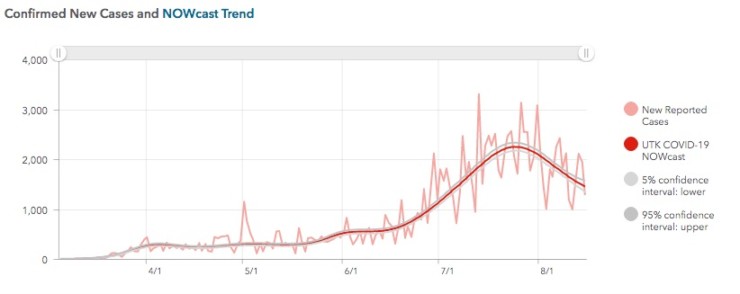
Although it has climbed back up some, the average number of new cases of COVID-19 per day in Anderson County fell by about 50 percent in the week that ended Tuesday.
It was the second consecutive week of a smaller number of new cases per day, on average, of COVID-19 in Anderson County.
It’s not clear what led to the drop in new cases per day or whether it might be related to the more widespread use of masks, including at businesses that started requiring them in the second half of July.
In the week that ended Tuesday, August 11, there was an average of 9.7 new cases of COVID-19 per day in Anderson County. That’s a level not seen since the first half of July, after the growth in COVID-19 cases had started to accelerate in the county.
The average 9.7 new cases per day last week was about 50 percent fewer cases per day than the average 18.6 new cases reported each day in the previous week, the seven-day period that ended Tuesday, August 4.
But since Tuesday, the average number of cases per day has climbed back up a bit to 12.2.
The highest average number of new cases per day, as tracked by Oak Ridge Today, was in the week ending Tuesday, July 28, when there were about 24.7 new cases per day. July appears to have been the worst month of the pandemic in Anderson County so far.
On Saturday, the Coronavirus-19 Outbreak Response Experts (CORE-19) at the University of Tennessee in Knoxville reported that the COVID-19 transmission rate in Anderson County was below one, at 0.97. When the transmission rate is below one, the disease is becoming less prevalent.
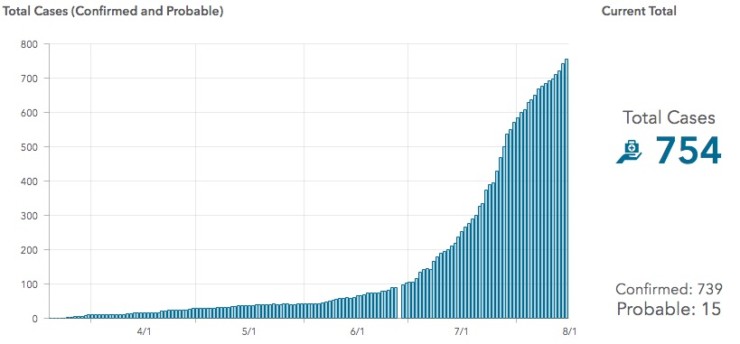
For more than a week, Anderson County reported no new hospitalizations due to COVID-19, although that has changed in the past two days. Two more hospitalizations were reported on Saturday and Sunday for a total of 32 since the first case was reported in the county on March 20.
No deaths have been reported in the county since August 4, according to Tennessee Department of Health information. There have been six deaths in Anderson County due to COVID-19.
The number of active cases has dropped by about 50 in the past two weeks, from a peak of 289 on Sunday, August 2, to 242 on Sunday, August 16. Active cases are total cases minus recoveries and deaths.
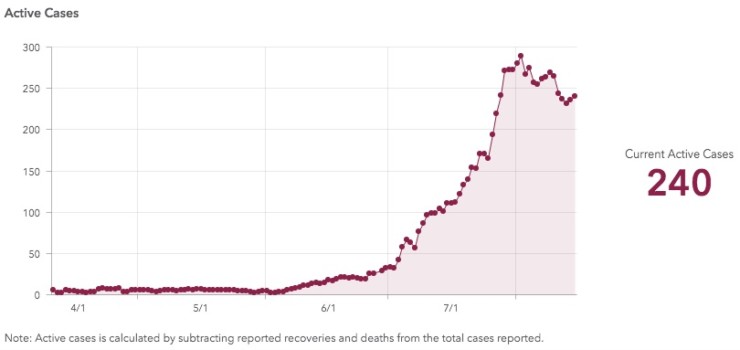
The average daily positivity rate has fallen three weeks in a row. The daily positivity rate compares how many patients test positive for COVID-19 each day to the total number of those tested each day.
In the seven-day period that ended Thursday, August 13, the average daily positivity rate in Anderson County was 4.8 percent. That was down from 5.5 percent the previous week, 8.7 percent two weeks earlier, and 9.6 percent in the week that ended Thursday, July 23.
World Health Organization guidelines say positivity rates should be at 5 percent or lower for at least 14 days before activities re-open.
The case doubling time is now back over 20 days. It was about 26 days on Sunday. That’s up from about 12 days three weeks ago. A longer doubling time means the virus is not spreading in the community as quickly.
Anderson County has reported 511 recoveries from COVID-19, although it’s not always clear what recovery means for every patient.
There have been 17,698 COVID-19 tests in Anderson County.
COVID-19 daily snapshot
Here are the COVID-19 statistics for Anderson County on Sunday, August 16:
- Total cases—759
- New cases—5
- Active cases—242
- Recovered cases—511
- Deaths—6
- Total hospitalizations (current hospitalizations could be different)—32
- Total tests—17,698
- Daily positivity rate—2.6 percent
- Total positivity rate (comparing all positives to all tests since the pandemic began)—4.3 percent
- Hospitalization rate—4.2 percent
- Death rate—0.8 percent
- Recovery rate—67.3 percent
- Case doubling time—26 days
- Transmission rate (on Saturday)—0.97
Seven-day case and daily positivity rate averages
Here are the recent seven-day averages of new daily COVID-19 cases in Anderson County calculated by Oak Ridge Today:
- Week ending June 30—3.43 new cases per day
- Week ending July 7—5.86
- Week ending July 14—10.86
- Week ending July 21—15.4
- Week ending July 28—24.7
- Week ending August 4—18.6
- Week ending August 11—9.7
Here are recent seven-day averages of daily positivity rates:
- Week ending July 9—5.45 percent
- Week ending July 16—9.37
- Week ending July 23—9.6
- Week ending July 30—8.7
- Week ending August 6—5.5
- Week ending August 13—4.8
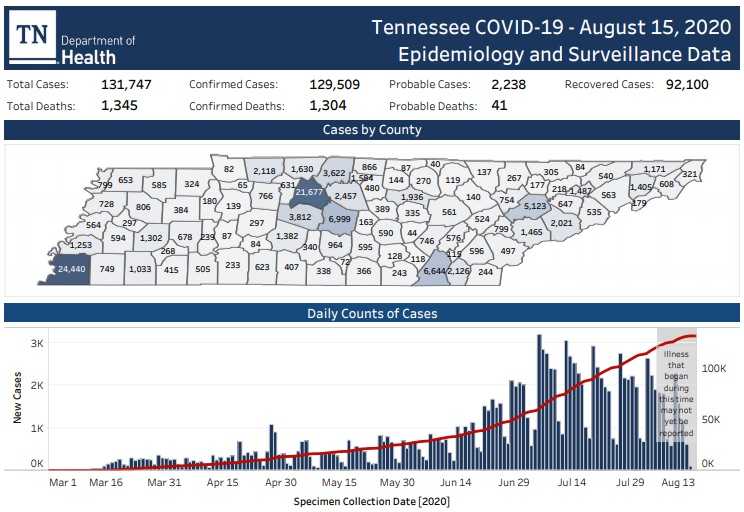
State, county statistics
Here are the COVID-19 statistics for Tennessee on Sunday, as reported by the Tennessee Department of Health:
- Total cases—133,708
- New cases—1,961
- Active cases—39,687
- Deaths—1,366
- Death rate—1 percent
- Recoveries—92,655
- Recovery rate—69.3 percent
- Hospitalizations—5,847
- Hospitalization rate—4.4 percent
- Current hospitalizations (on Saturday): 964, with 184 pending
- Daily positivity rate—7.1 percent
- Total positivity rate—7.2 percent
- Average patient age—39
The first case of COVID-19 was diagnosed in Tennessee on Wednesday, March 4. Since then, there have been more than 1.8 million COVID-19 tests in Tennessee.
The highest number of cases in the state is in Shelby County, which includes Memphis in West Tennessee. The case count there was 24,692 on Saturday, up more than 2,000 compared to August 7, about eight days earlier. There have been 327 deaths in Shelby County.
In Davidson County, 21,893 cases have been reported, an increase of close to 2,000 cases since August 7. In that county, 227 deaths have been reported. Davidson County includes Nashville in Middle Tennessee.
Other counties with case counts of more than 1,000 on Saturday included:
- Rutherford (Nashville area), with 7,080 cases and 59 deaths;
- Hamilton (Chattanooga area), with 6,801 cases, up about 1,000 cases since August 7, and 59 deaths;
- Knox (Knoxville area), with 5,231 cases, an increase of almost 1,000 cases in eight days, and 42 deaths;
- Williamson (Nashville area), with 3,861 cases and 26 deaths;
- Sumner (Nashville area), with 3,636 cases and 75 deaths;
- Wilson (Nashville area), with 2,484 cases and 24 deaths;
- Bradley (Cleveland area, near Chattanooga), with 2,166 cases and 16 deaths;
- Montgomery (Clarksville area), with 2,150 cases and 16 deaths;
- Sevier (Gatlinburg, Pigeon Forge, Sevierville), with 2,038 cases, up more than 200 cases in eight days, and 9 deaths;
- Putnam (Cookeville area), with 1,931 cases and 20 deaths;
- Robertson (east of Clarksville), with 1,638 cases and 21 deaths;
- Trousdale (Turner Trousdale Correctional Center), with 1,585 cases and 6 deaths;
- Hamblen (Morristown area), with 1,494 cases and 15 deaths;
- Blount (Maryville area), with 1,477 cases, up more than 200 cases in eight days, and 15 deaths, another six deaths in eight days;
- Washington (Johnson City area), with 1,455 cases and 2 deaths;
- Maury (Columbia area, south-southwest of Nashville), with 1,433 cases and 10 deaths;
- Madison (Jackson area, between Nashville and Memphis), with 1,330 cases and 26 deaths;
- Tipton (Memphis area), with 1,256 cases and 12 deaths;
- Sullivan (Kingsport-Bristol area), with 1,197 cases and 16 deaths; and
- Hardeman (south of Jackson), with 1,056 cases and 18 deaths.
Here is COVID-19 case information about other counties besides Knox County that surround Anderson County:
- Loudon County has reported 809 cases, up about 100 cases in eight days, and three deaths.
- Roane County has reported 533 cases, up more than 100 cases in eight days, with two deaths.
- Campbell County has reported 271 cases and one death.
- Union County has reported 177 cases with no deaths.
- Scott County has reported 142 cases with two deaths.
- Morgan County has reported 141 cases with one death.
COVID-19 is a new, contagious illness that can have respiratory symptoms and affect other parts of the body, and it can be deadly. It can cause a range of health issues that can last weeks or months, including fevers, body aches, fatigue, coughing, and breathing problems, among other reported symptoms. The long-term effects remain unknown.
It can be spread by respiratory droplets from coughing, sneezing, talking, and singing. There is also debate about whether it might be spread by airborne transmission.
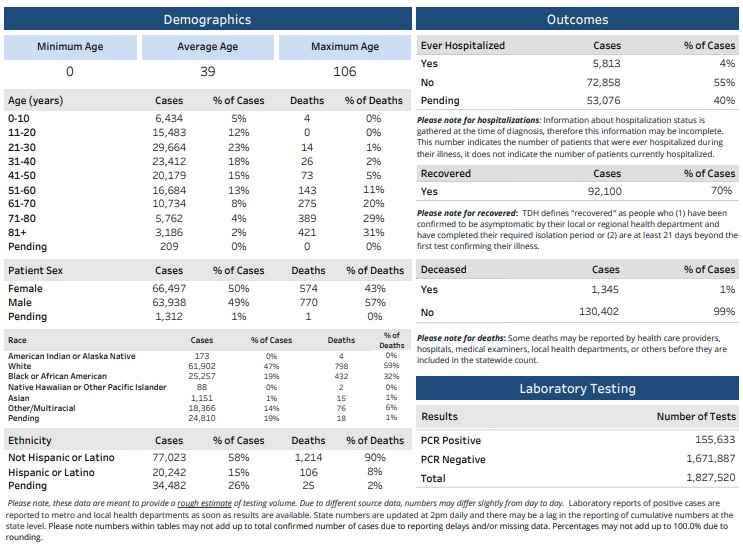
The disease appears to be especially deadly to older patients, according to data from the Tennessee Department of Health. As of Saturday, there had been at least 14 deaths among all age groups 21 years old and older, and 73 or more deaths starting with the 41-50 age group. The number of deaths continues to climb in older age groups. There have been between 143 and 421 deaths in the four oldest age groups: 51-60, 61-70, 71-80, and 81 and older.
The largest number of cases continues to be among patients who are 21 to 30 years old, followed by patients who are 31 to 40, and then patients who are 41 to 50.
While some people report no symptoms or mild symptoms, others become seriously ill from COVID-19, sometimes for weeks, and the effects can sometimes last for months. Others are admitted to the hospital, and some patients end up in intensive care and on ventilators.
To help prevent the virus from spreading, officials have repeatedly recommended that residents wear a face mask or covering when they are out of the house and around others, maintain a distance of at least six feet from other people when possible, and wash their hands frequently.
See the state’s data here and here.
See the CORE-19 website here.
See previous story here.
Leave a Reply